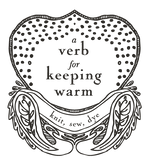
Happy 2016!
This year I am dedicated to helping others create their own natural dyeing practice. And hoping to facilitate a community which can support one another's work and provide friendships and inspiration.
To do this, I have created The Modern Natural Dyer Work-Along. Each month, I will choose a project from my new book, The Modern Natural Dyer. My studio cohorts Sarah and Lis and I will each make our own rendition of this project, post it to the blog, and give tips and tricks. In January, we will be making the Northwoods Hat and Sock Hop.
Before we dive into the projects, let's starts with an overview of the book. Below, I have listed the chapters, including a short explanation of the content in each, why I chose to include such information in the book, and how it matters in the natural dyeing process.
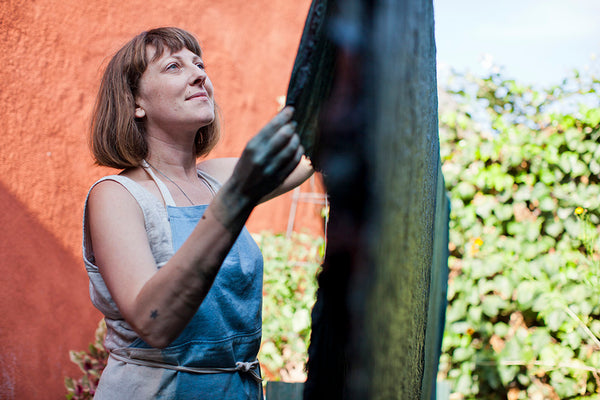
HI! I'M KRISTINE.
I grew up knitting and sewing. I always took fabric and yarn for granted, never giving much thought to how it was made, as if it just magically appeared on the shelf. It wasn't until I travelled to India to study Art and Architecture, when it seemed that every corner I turned, I ran into someone spinning cotton, dyeing, or weaving that my world expanded and I began to go deeper into the process of making yarn and fabric.
When speaking to dyers, I came to realize that some people used natural dyes - dyes made from plants. I loved to listen to their stories of how their families had been using natural dyes for centuries, their journey of collecting their dyes, and witnessing their process of applying minerals and metals to shift and capture color. Because their families had been practicing natural dyeing uninterrupted for centuries, their practice is quite cyclical. I had a hard time discerning where to start. This inspired me to learn how to create my own natural dyeing practice, to develop a way to teach others how to create their own practice, to create A Verb for Keeping Warm, and to write The Modern Natural Dyer. I desired to discover which paths I would take to gather my natural dyes, and who I would meet along the way. Plus! I was enraptured by the idea of being able to create my own dyed yarn and fabric so that each piece I created carried and communicated a deeper story of my journey towards making that piece.


THE DYES
The Modern Natural Dyer opens with a twenty page spread of commonly-found natural dyes which have a history of long-lasting color. If you want to create color which will be long-lasting, these are the dyes I suggest to use. Sure, there are more obscure dyes which are fascinating, like mushrooms, but for this book, I really want the process of natural dyeing to be accessible to many if not all people.
Flipping through the pages, each dye is highlighted. I included examples of all of the different forms the dye can be found. For instance, in the madder photo, you can see the madder root and the madder extract, a highly concentrated powder derived from the madder root. I spent a year growing all of the plants featured in the book.

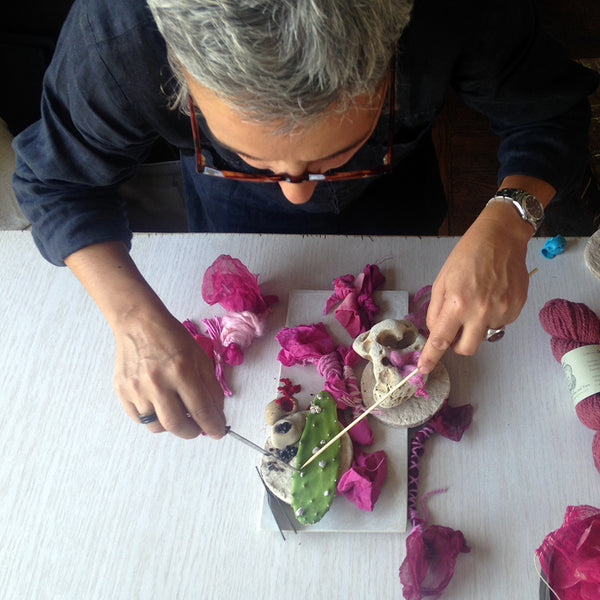
The one insect featured in the book, cochineal, was culled from the backyard of Adrienne's parents house. Adrienne is Verb's scouring and mordanting technician, and my co-dye-gardener. Her parents live in Indio, California, a town about an hour from the border of Mexico. These photos are of Alessandra, my amazing stylist, taking cochineal and placing them into the vignette to be photographed for the cochineal dye page - and which ultimately made it onto the cover of the book.
I created little packages of fiber, yarn, and fabric, which I threw into the dyepot at different times during the dyeing to achieve a variety of colors, so that each photograph would communicate the range and shade of color each dye could create. There is text describing each dye, including tidbits about the history of the dye, and where it can be found.

FIBER TYPES
In dyeing, the word "goods" is used as an overarching term to refer to things-to-be-dyed, like fiber, yarn, fabric, socks, t-shirts, etc. Before beginning the dyeing process, it is important to identify the content of the goods you would like to dye. There are two types of natural-fibers: protein-based (animal or insect based) and cellulose-based (plant-based). This section teaches how they are different, to identify each type, the variety of natural fibers available, and how each different type interfaces with natural dyeing.
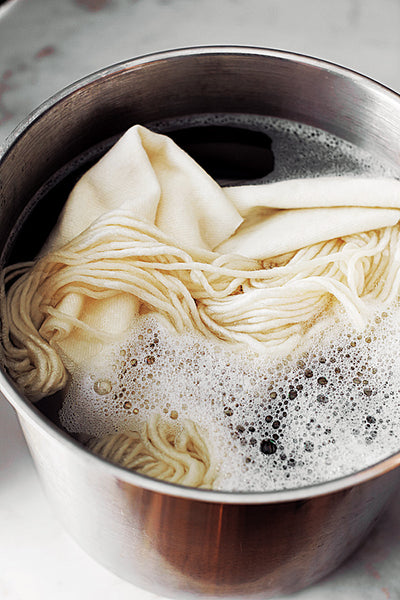
DYEING 101
This section in the book covers the general process of natural dyeing. And the tools required and recommended to begin the process. I love that natural dyeing utilizes the kitchen, pots, pans, measuring cups - a space so familiar to most of us.
There are a few steps to take before heading to the dyepot which will ensure long-lasting color.
+ Weigh the goods. Record the weight.
+ Pre-wash the goods - referred to as scouring in the dye world.
+ Mordant the goods. This is the step of applying a binder to the goods. It is the binder which accepts the dye and holds the color.
With those steps complete, it is time for the fun part - dyeing! This section of the book gives a general review of the natural dyeing process.
Washing and caring for your naturally-dyed goods is also included in this section.
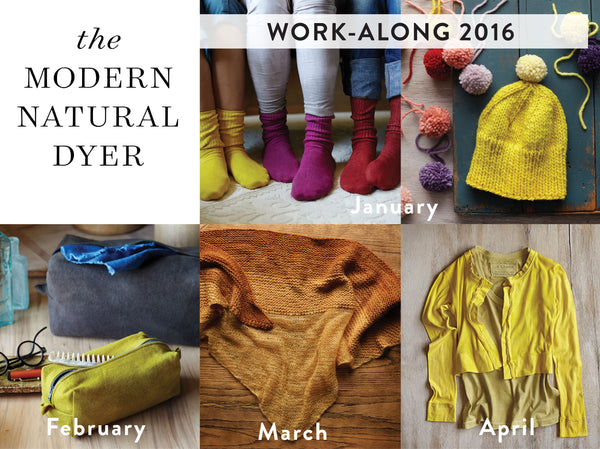
PROJECT-BASED LEARNING
In the second half of The Modern Natural Dyer, there are 20 projects each exploring a different part of the natural dyeing process. Some require knowing how to sew or knit. Other projects utilize white pre-sewn or pre-knit objects which are referred to as blanks. They are made with the intention that one would take them and dye them.
When beginning the task of starting to write my book, and faced with the question of how to inspire and motivate others to begin natural dyeing, I acknowledged two spheres of great influence: my experience helping customers at Verb and the influence cookbooks have had in my life.
At Verb, we have a number of knit and sewn samples using yarn, fabric, and patterns we carry here in the shop, on display at all times. Time after time, I see people become very excited when seeing these samples, and set out to make their own version. This process has encouraged people to stretch their skill-set, and become better at their craft. My hope is the projects in the book will do the same. Perhaps you see a project you love, and decide to take the steps to make it.
I love to cook and bake. I think of natural dyeing as the cooking of the fiber world. The processes are very similar. I owe a large part of my ability to do so to well-crafted cookbooks; those that have solid instructions and enticing photography.
When writing my book, I drew upon the format of cookbooks. One such favorite is Jerusalem by and
So I decided to create a project-based book.
In addition to my hope that the projects would inspire and entice, there is the fact that each project works as a tool to teach a different part of the natural dyeing process. By framing the process within the a project, I was able to teach more in-depth skills as I am referring to an exact example of use - rather than a lesson based in theory.
My book includes instructions on how to naturally dye protein-based (animal / insect) and cellulose-based (plant) fibers, how these fibers affect the natural dyeing process, and how to work with each fiber in order to get the best results. Protein- and cellulose-based fibers are very different from one another. Because of the inclusion of both types of fibers, projects once again helped to frame lessons in learning how to work with them.
Through the projects I hope to impart what natural dyeing could look like in your life - in both process and product - like a naturally dyed dress or sweater, or even as a simple as a pair of vibrant naturally-dyed pair of socks.
The second half of the Modern Natural Dyer is dedicated to teaching you about the different types of natural dyes available and how to use them. This section is divided into the following chapters:
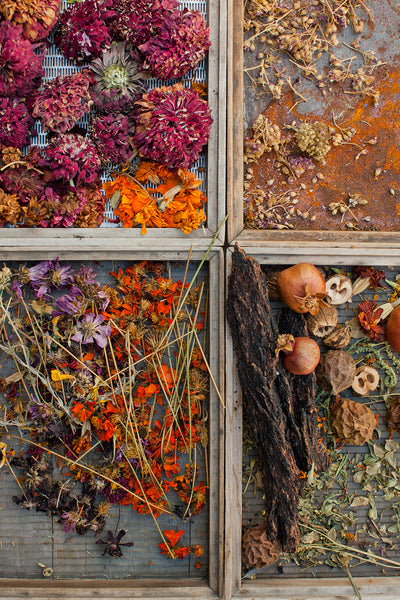
WHOLE DYESTUFFS are dyes found whole, so things like flowers, roots, leaves, bark, and bugs. To use whole dyestuffs, the color must be extracted from the plant material. Some dyes are only available as whole dyestuffs - like goldenrod - and are likely to only be found by growing them in your garden or foraging for them in the forest.

NATURAL DYEING EXTRACTS are highly concentrated powders derived from plants and cochineal. To use extracts, they are measured and dissolved. They are easy to store, available for purchase, and are the easiest way to create a wide spectrum of color.

INDIGO has its own chapter, and is separated from the other natural dyes, as the process of dyeing with it is quite different than all the other natural dyes and requires special additional steps.



The final chapter in The Modern Natural Dyer is dedicated to SURFACE DESIGN. The idea behind this section is now that you know about the dyes and how to use them, now let's use this knowledge to create patterns. Once upon a time, there wasn't fancy machinery that could print fabric. Instead, to make designs on fabric, there were groups of people dedicated to manipulating fabric, into forms like tucks, pleats, and folds, to create patterns. Sometimes this person would also be the dyer, and sometimes this would be the person's sole job.
In this section of the book, you can learn how to paint on fabric and yarn. There are also four styles of resist-dyeing taught. Resist-dyeing is the act of binding the fabric, so that when dyed, dye cannot reach the bound portion. Once the dyeing is complete, the binding is removed, and a pattern emerges. In Japanese, the overarching term for this is shibori and each type of resist applied has its own name. In The Modern Natural Dyer, I teach how to create resist-dyed fabrics by wrapping the fabric with thread, stitching fabric with needle and thread, pleating the fabric and binding it to a pole, and pleating the fabric, adding blocks, and applying pressure with the use of clamps.
And that is The Modern Natural Dyer in a nutshell!
---------------------------------------------------------
When designing the projects for the book, I worked to create things which are simple, classic, and easily modified to reflect your personality - like using a different dye to achieve new color, or applying a resist-dyeing technique to create your own unique pattern. While writing my book, I spent hours envisioning how you might take these projects and interpret them, and imaging how fun it would be create these projects along your side.
I am so excited to embark on this journey with you!
We are busy as bees in the Verb dye studio.
For those of you who have purchased The Modern Natural Dyer Phase 1 Kit, we are preparing the kits to ship to you.
I am teaching a three-week Natural Dyeing 101 course at Verb, starting next week. This is a thorough introduction to the natural dyeing process and will include dyeing on protein- and cellulose-based fibers. There are still a few spots left!
And in case you missed it, we are currently offering FREE SHIPPING on copies of The Modern Natural Dyer.
If you are working-along with us, use the comment section to introduce yourself, and to link to your blog or Instagram feed. And remember to tag your photos with #themodernnaturaldyerworkalong so we can follow your progress.
Sarah, Lis, and I have begun the first highlighted project, The Northwoods Hat. In the next few days, I will post our progress.
On Tuesday, January 12th, my first Creativebug video is coming out - and will teach you how to naturally dye a silk scarf!
See you soon!
-- Kristine
